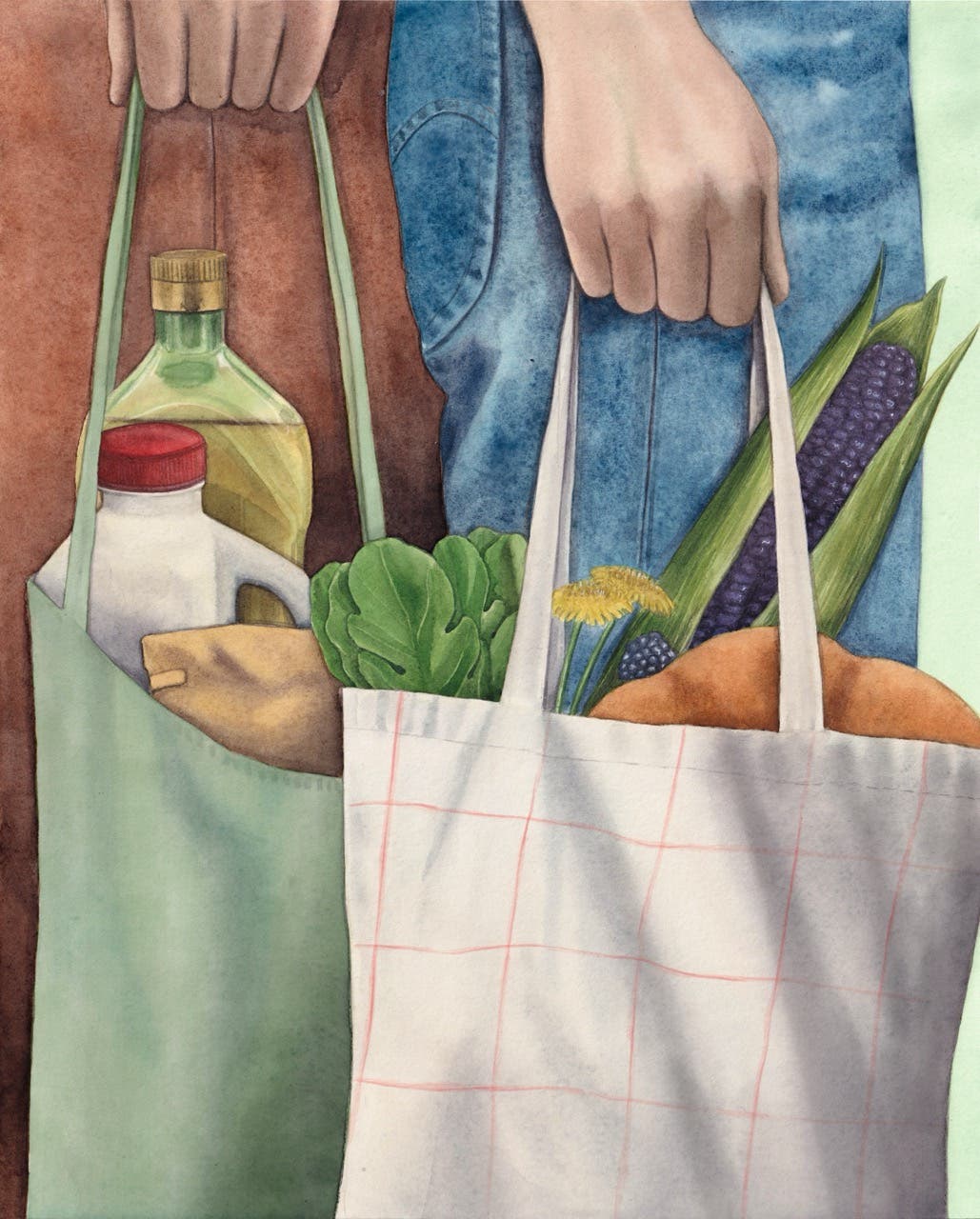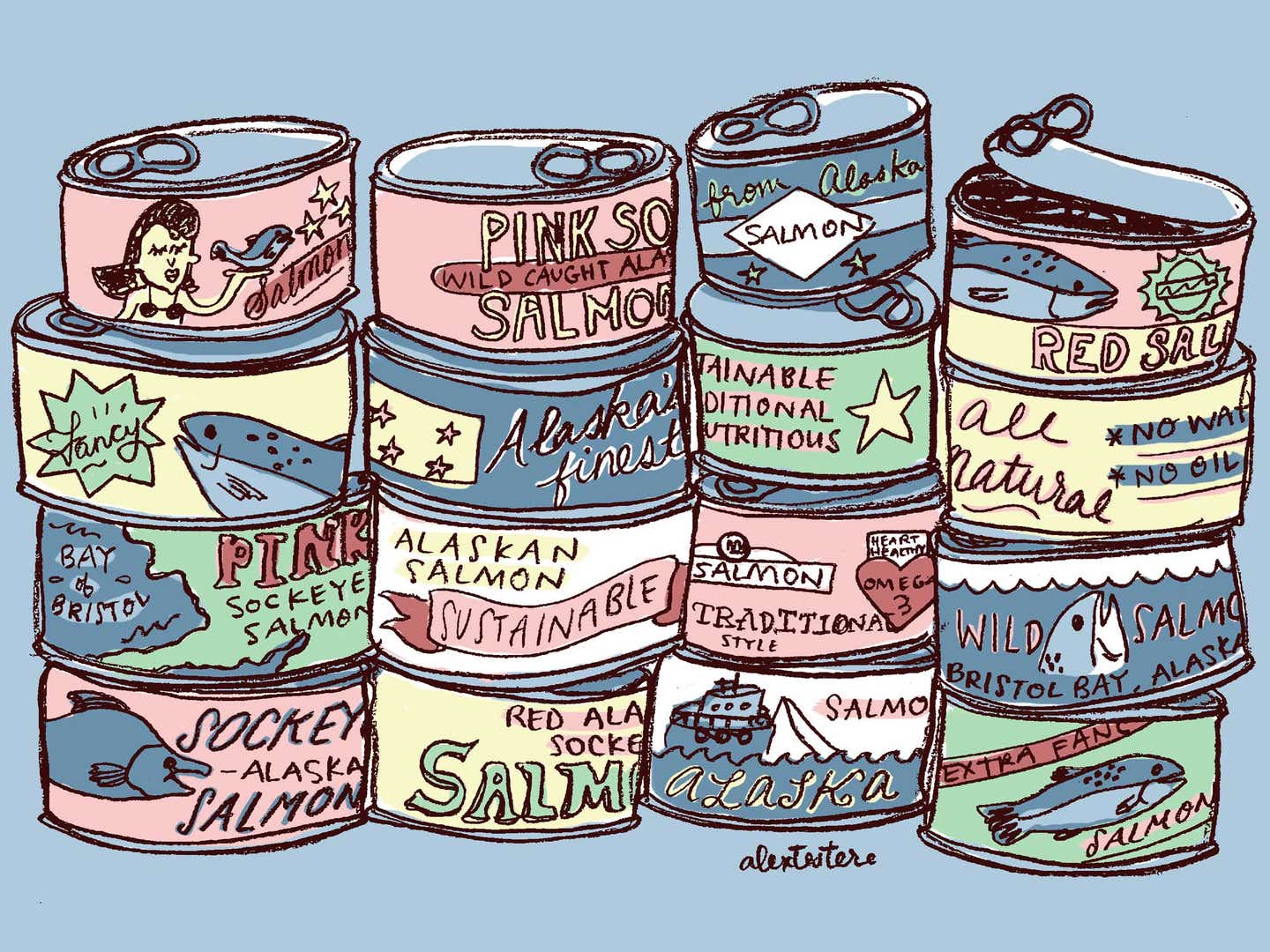
The Cockamamie, So-Crazy-it-Just-Might-Work Scheme to Save Alaska’s Excellent Salmon From Itself
Bristol Bay’s sockeye salmon is a national treasure: delicious, plentiful, and shockingly sustainable. The problem: Fishermen are too good at catching it, and what can’t get sold fresh winds up in cans no one wants to buy. But if a new plan succeeds to make canned salmon more appealing, it just might rescue an industry threatened by its own wild success
It's another bumping night at Maiden Lane in New York City, a trendy bar and restaurant in the forever young East Village that draws nightly crowds for its craft cocktails, weird European wines, and dishes consisting of little more than a can of super-high-quality preserved seafood on a plate. Diners ogle over tender octopus luxuriating in olive oil and $15 cans of smoked mussels packed in something mysteriously named "Galician sauce"—and they're loving it.
The canned stuff—"tinned" in upscale parlance, conservas if you want to tug on the Spanish cachet—is Western European luxury food akin to foie gras and Comte. It comes wrapped in elegant or attractively vintage labels and originates in some picturesque coastal town in France or Spain. But one can that recently edged its way onto the table tells a different story. The label is pretty but not vintage, the origin picturesque but not exactly accessible, and definitely not in Europe. The origin is Bristol Bay, Alaska, where highways don't go, almost no one lives, and canning fish is more necessity than delicacy.
Inside are hunks of beautiful deep orange salmon meat, pleasantly oily and perfect except for maybe a squeeze of lemon. The crowd loves it, too. Which is good news, because that can of salmon isn’t just a can of salmon. It represents an outlandish hope for the best possible future for some of the hardest-working people in the American food industry. And, if the right circumstances line up, it maybe, just maybe, could save one of the country’s most precious natural resources from its own crazy success.
The Wonderful, Terrible Salmon Glut
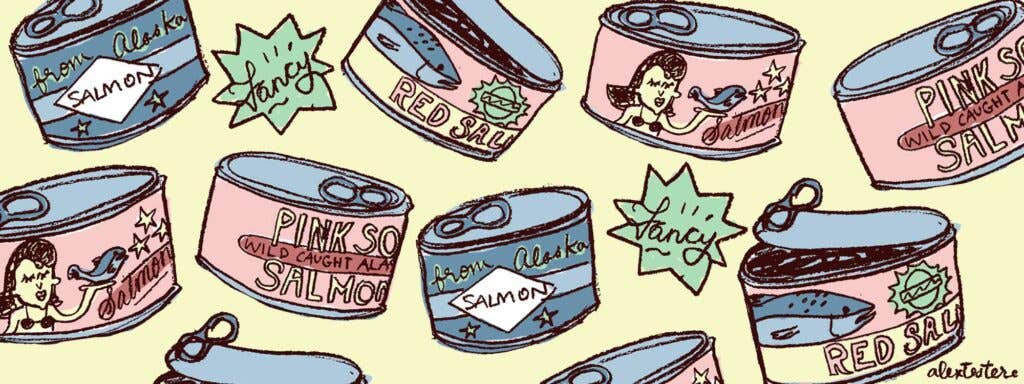
This year, as every year, June 1st marked the start of salmon fishing season in Bristol Bay Alaska. This is when the salmon start muscling their way up into one of the five river systems that spit out into the bay that’s cradled by the curve of the Alaska Peninsula, and by late June the sockeye—the area’s most plentiful and profitable species—will be pouring in. For a few brief but furious weeks, Alaska’s fishermen will haul them up in nets by the hundreds. And by the end of July the season will be over.
This year, forecasts say the catch will be smaller than last year. And for the people who earn their living catching salmon in Alaska, that’s a really good thing.
Though 2015’s sockeye season got off to a late start, the total harvest hit 37 million fish, the largest the industry had seen in 20 years. To anyone who has paid any attention to the seafood-related headlines of recent years, most relaying news of crashing populations and emptying oceans, this might sound, well, fishy. But Bristol Bay is about as far from over-harvesting as a fishery can get. Where the wild Atlantic salmon was all but decimated in the ‘80s, Bristol Bay’s wild salmon—the largest sockeye population in the world—is healthy and robust. It’s carefully managed by the Alaskan government (which has the mandate to sustain natural resources written into its constitution) and has been steadily growing by the decade.
The problem is that all that salmon gets harvested within a mere two months, and even though salmon is one of America’s most beloved fish, there’s simply no way to sell tens of millions of pounds while it’s still fresh. Instead, fishermen sell most of their catch to processors that either freeze or can it. And that stuff just isn’t selling.
It’s no surprise that consumers—especially the sort of consumers who prioritize sustainable, wild-caught fish like Bristol Bay salmon—tend to prefer fresh over frozen food, and anything over canned. And since fish farming has made fresh, inexpensive salmon available all year round, wild salmon has struggled to compete.
Frozen does better than canned: It at least sells when prices hit rock bottom, as they have in the recently saturated market, and a market analysis last year found that sales of frozen sockeye rose around 200 percent in the first part of 2015, while prices were down 43 percent. Plus frozen sockeye can be sold as "previously frozen" thawed fillets, which are a more appetizing option sometimes even presented as "fresh."
On the other hand, canned salmon—which makes up about a third of the annual catch—has the reputation of something only a ‘50’s housewife would use to make her famous salmon loaf, perhaps, or a vintage molded salmon mousse. If you’ve noticed canned salmon at all on a grocery store shelf in recent years, it’s probably squeezed in between the tuna and the sardines, maybe with a label that hasn’t changed much in decades, possibly filmed with dust. The vast majority of people still buying it are, for the most part, elderly, and shrinking in number. And the same market analysis of last year found that while canned salmon production rose 51 percent between 2013 and 2014, sales only rose four percent. So last year, when that record catch was rolling in, processors were still sitting on fish, mostly canned, from the past two years.
At that point, the USDA stepped in to buy about $30 million worth of cans, to be distributed to food pantries across the country in an effort to artificially bump up demand. But for fishermen forced to sell the majority of their catch to processors, the backlog was nothing short of a disaster: Fishermen found themselves getting only 50 cents a pound for their pristine catch, a shocking drop from the previous year's prices of $1.20 and up. According to the Alaska Department of Fish & Game, their record sockeye harvest only brought in about $92 million, whereas 2014's harvest was worth a full $100 million more than that.
Welcome to Canning Town
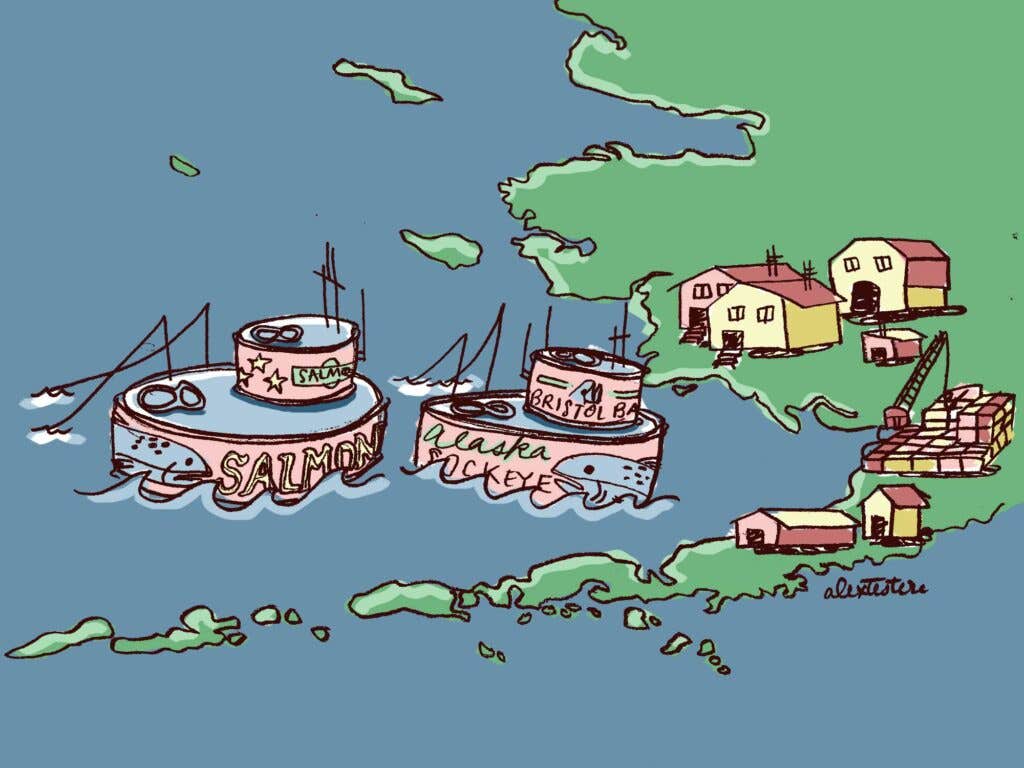
That finger of Alaska that sweeps around Bristol Bay and out into the Bering Sea is dotted with tiny Native American villages, most populated with well under 100 people each, along with several slightly larger towns. Dillingham, which is considered the city hub of the region, has a population of just under 2,500 and is only reachable by boat or plane. Still, just about every village has at least one salmon packing plant, and for residents, the fishing industry accounts for most of their job options. And though other parts of Alaska host larger populations of other species, like the pink salmon, sockeye is prized for its richer flavor and vibrant red flesh, making Bristol Bay’s sockeye fishery the most valuable of its kind in the state.
But as the market stalls out and fish prices drop, it's getting tougher to make a living on salmon, tougher for those villages to remain intact, and ultimately tougher for the sockeye to remain a valued and cared-for resource. That's because Bristol Bay's only other potentially valuable resource is the untapped Pebble Mine, an enormous copper deposit. For years most locals have fiercely opposed attempts to mine this deposit because of the toxic chemicals it could potentially introduce into the water-based ecosystem. Any sort of leak or runoff could poison the whole area, and with it a third of the world's sockeye. That would truly be the end of the fishery, but for some of the locals already struggling to get by, a job at the mine is starting to seem like the best bet anyway.
One of those reluctantly weighing the benefits of the mine is Brad Angasan, an Alaska Native who for now is still devoted to his role as a fourth-generation fisherman. He grew up in the village of South Naknek, where his family had lived since his grandfather's generation arrived there in 1912. They had paddled there in skin bidarkas from further up the Naknek river, escaping the massive eruption of Novarupta Volcano, which buried their old village in ash. Angasan's grandparents fished for salmon by sailboat, and his family has had its fishing permit since the state started issuing them in the late '70s.
Angasan, who inherited that permit from his father, lives and works in Anchorage now, but goes back every summer for the salmon run. “I can remember day one on my grandma’s boat,” he says. “I was five. All I did was pack fish and I earned $500.” Now Angasan’s 14-year-old son, Matthew, carries on the tradition. “He’s been coming out since he was three,” Angasan explains proudly, “but he’s only been a paid crewman since he was 13.”
Angasan has every intention of passing his permit down to his son, as his father did for him, but “The salmon market is in a terrible state right now,” he says. “Every season that we gear up and prepare for the harvest is a huge gamble.”
Even at its best, the job is a grueling one. Elsewhere in Alaska, other salmon seasons run longer and slower, but in the short Bristol Bay season, every minute counts. The boats rush into the bay on opening day and stay out as long as possible. Between open fishing periods, which might last three hours or might span several days, the boats wait on the bay, nets poised to re-enter the water. “Then we fish every hour we’re allowed to,” Anagasan explains. “The buoy hits the water as soon as the period starts, and comes up as late as it can.” To go back to port between each period would be a waste of time and fuel, so the 32-foot boats and their four- or five-person crews rarely touch land in the two-month season.
As the returns for that hard work shrink, local fishermen like Angasan are dwindling, replaced by full-time fisherman who migrate from harvest to harvest. His own village of South Naknek now houses fewer than 70 people, whereas “30 years ago, it was probably closer to 150.” He blames that steep decline on the loss of the village’s packing plants. Many years ago, South Naknek housed two processing plants and two fish camps, which housed seasonal workers and fishermen. Now, “Of those four, none of them process anymore—Trident Seafoods was the last, back in the ‘90s,” says Angasan.
Last fall, the last fish camp shut down too. The same thing has happened to the Native villages up and down the peninsula, so that hardly any local jobs remain. With nothing else near enough to commute to, more and more families are moving to big cities like Anchorage. “It’s potentially a death knell for our community,” Angasan says. Once too few families with children remain to justify keeping the local school open, the rest move away too, and the village dissolves along with the Native community it contained and many of the traditions that community upheld.
“These villages are dying, literally dying, all up and down the Alaskan peninsula,” Angasan laments. “When that happens there is a loss of identity, a loss of culture.” It also means the potential loss of one of the world’s rich natural resources. With a shrinking number of people to oppose Pebble Mine, and a growing number of people desperate for the jobs it would provide, the mine—and the environmental damage it could bring—looms over the bay.
The fate of the Alaska Peninsula rests largely on the fate of the fishing industry, and the industry would benefit enormously by selling more canned salmon. And that won’t happen without a major image overhaul. Canned salmon needs new angles, new messages—it needs a makeover. And it needs it now.
Yes We Can
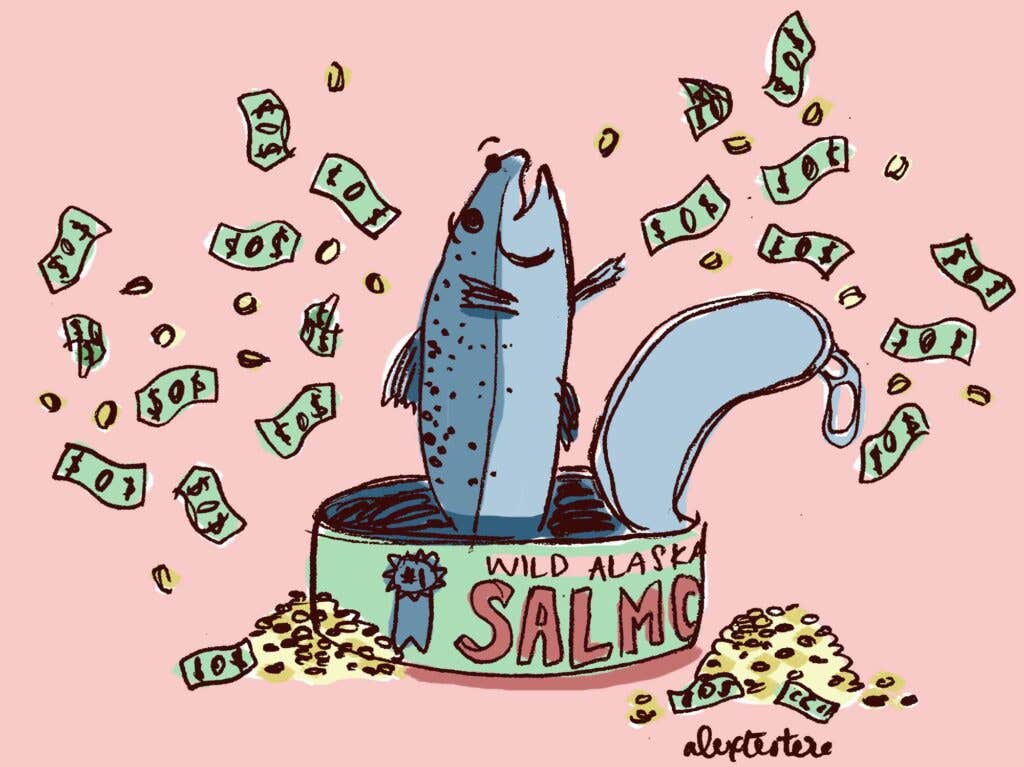
In the history of American canned fish, salmon came before tuna. It was the first fish canned on an industrial level, starting in the mid-1860s, and canneries once made up backbone of the salmon fishing on both the East and West coasts. But along the way, canned salmon lost the contest for pantry ubiquity to tuna.
As Andrew Smith explains in his book American Tuna, people used to think of tuna as oily and gross. But sometime in the early 20th century, new technologies made it not only easier to catch large tuna, but also to extract some of the oils from their flesh, yielding a product about as mild as canned seafood can taste. The new tuna reminded some people of chicken—the chicken of the sea, if you will—and so companies marketed it heavily with that angle (eventually spawning the actual Chicken of the Sea brand). Canned salmon got no such treatment.
According to USDA data collected by the Washington Post, tuna consumption was skyrocketing by the 1940s, and by the 1950s tuna sales had outpaced salmon. To this day, tuna salad occupies a place in just about every cafeteria, deli, and diner in the country, while canned salmon remains stuck on a bottom shelf with a retro (dis)reputation shared by the likes of Vienna sausage.
Bristol Bay's fishermen desperately want to reverse that. In 2005 they took the enormous step of banding together to form the Bristol Bay Regional Seafood Development Association (or RSDA), an organization funded by a one-percent assessment on the total harvest of each fisherman. That was not an easy move for such a ferociously independent bunch, and close to half opposed it at first, mostly over the fee. But Bob Waldrop, the executive director of the RSDA up until 2014, says that it's been revolutionary for the way the Bristol Bay fishermen do business.
It started out with infrastructure: "An individual fisherman is not likely to build an ice machine or help the port buy a boom truck to help fishermen get the fish off their vessels. But the whole fleet could easily do that," says Waldrop. But in the past three years, the RSDA has turned its attention to marketing. Now a website extolls the benefits of Bristol Bay sockeye while Sockeye Restaurant Week gets restaurants across the country to push salmon entrees.
Then, last year, the RSDA also spent a small chunk of money on a bolder approach: They gave a $15,000 grant (plus 300 cans of salmon) to Robert LaValva, the New Yorker responsible for New Amsterdam Market (a weekly regional food market, currently on hiatus) to run a small pilot project re-branding canned salmon for a few specialty food stores in Manhattan and Brooklyn.
His idea: Target the upscale restaurant-going set, the kind who don’t bat an eye at spending up to double digits on a few ounces of quality canned seafood. Make the cans chic and focus on the quality of the fish. Look to Europe, where in countries like Spain and Portugal the art of canning delicate shellfish and pricey tuna sits right up there with making charcuterie.
In that context, canned salmon has everything going for it. "It's one of these rare things that's really bountiful, and nonetheless harvested in a sustainable way," says LaValva, "and it's extraordinarily healthy because it's extraordinarily clean. There's almost nothing left like this." Canned Alaskan sockeye, especially traditionally packed, skin-on, bone-in versions like the easy-to-find Natural Sea brand, has more in common with those Spanish conservas than it does with tuna salad. With no water or oil added, it sits in a pool of its own juices and bright, poppy-colored oil, clearly much richer than water-packed tuna, and worth eating without much more than a little salt and a squeeze of lemon juice.
It's just the thing to latch on to a growing American interest in high-end tinned fish, which has seen more and more restaurants and bars outside of Spain realizing the appeal of a delicacy that requires almost zero effort to prepare. Some, like Maiden Lane, have even made it acceptable to serve a menu of almost nothing but canned seafood. D.C. chef Jose Andres now sells his own line of pricey conservas in Whole Foods. The only thing barring canned salmon access to this cachet is the whim of public perception.
LaValva teamed up with Maiden Lane for his pilot project. They designed a new artful label (the best conserva labels often look like works of art) and placed cans on shelves at two other popular New York shops/restaurants besides Maiden Lane: Saltie, a tiny lunch spot that, among other things, does great work with smoked fish; and Harry & Ida's Meat and Supply Co., newly famous for its new-school homemade pastrami.
The pilot was a wild success and the 300 cans of sockeye sold out fast. For a product with such a disreputable reputation, this is huge, positive, hopeful news.

At this point, the RSDA-funded project has wound down, but LaValva has not. He wants to continue his rebranding project on his own, because he thinks the RSDA has put too much effort towards marketing canned salmon as an ingredient in rejiggered versions of the same old ‘50s recipes, and not enough towards simply selling it as a high quality canned fish. “We learned enough to be convinced it would be worth launching a new private ‘hipster’ label,” he says. “I’d like to see it pay off for me, yes, but I also see it as a social mission.”
But “I would need to raise some money and figure out the distribution,” LaValva continues, and, with other projects in the works, “I haven’t done that yet.” There are other challenges: Expanding his reach beyond a few specialty shops will take time, and the audience for luxury canned salmon may be stronger in cities like New York than in the country as a whole.
In the meantime, the RSDA has just begun work on a campaign to develop a brand identity of its own for Bristol Bay sockeye. In May it announced that Copper River Seafoods had agreed to put that logo—a simple, modern-looking insignia that boasts "simply wild" and "naturally delicious"—on 100,000 packages of fresh salmon across the country.
Meanwhile, the fishermen out on Bristol Bay right now are finding more cause for hope in immediate improvements: A smaller harvest than last year, plus less competition from farmed salmon thanks to a sea lice outbreak in Norway and a toxic algae bloom in Chile. Processors have even sold through much of their backstock, and Copper River Seafoods took the unprecedented step of posting its prices before the sockeye start coming in, to give the fishermen some extra reassurance. The base price of $.75 a pound is a small but encouraging increase from last year, enough to leave fishermen cautiously optimistic about their new haul. And with the sockeye currently pouring into their nets, that's probably about all they'll have time to worry about until the season winds down and the fish retreat to the rivers.
This story has been edited to clarify the new initiatives the RSDA is taking to promote fresh salmon, not canned.
Keep Reading
Continue to Next Story









